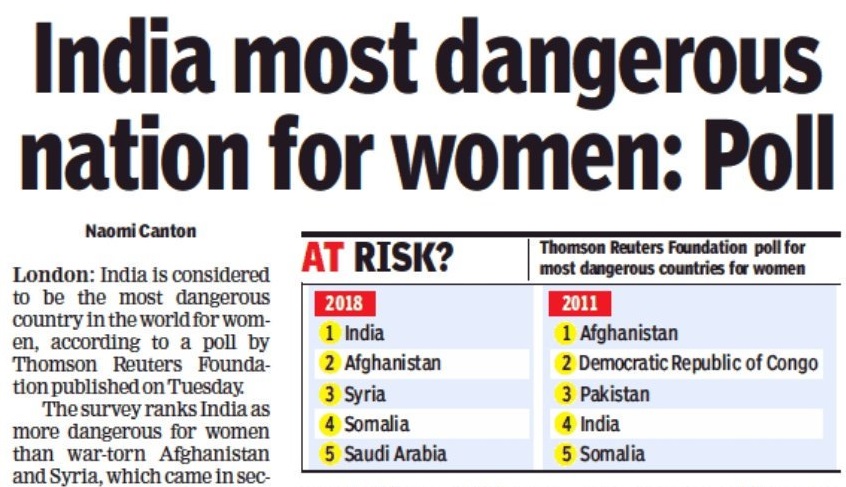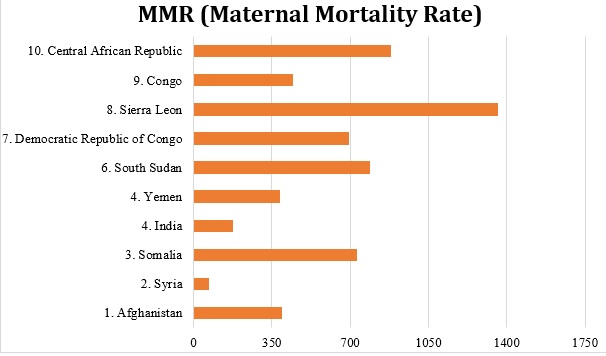The Reuters Foundation (taken over by Thomson Corporation in 2008 and thus renamed as the Thomson Reuters Foundation) was established to “raise the standards in journalism worldwide through media training and humanitarian reporting”. One assumes then that generating reliable reports based on factual evidence would be high on their list of priorities. A recent poll report published on the TRF website by Melinda Goldsmith and Meka Beresford, titled ‘India most dangerous country for women with sexual violence rife’, was widely reported in news media across the world.
- How was the Thomson Reuters poll conducted?
TRF’s report was based on “a global perception poll of experts in women’s issues to highlight the most dangerous countries for women”. TRF claims they collected responses between March 26 and May 4, 2018 from 548 experts spread across Europe, Africa, the Americas, South East Asia, South Asia and the Pacific. The poll was conducted over the phone, online and in person, and the experts included “aid and development professionals, academics, health workers, policymakers, non-government organisation workers, journalists and social commentators”.
The first such poll conducted by TRF in 2011 had named ‘top five dangerous countries of the world’, with India ranking 4th, behind Afghanistan, the Democratic Republic of Congo, Pakistan and Somalia. The 2018 perception poll consisted of seven questions and provided a ranking based on the number of times a country appeared in a response. The results only reveal the names and order of the “top ten dangerous countries for women”. Out of the seven questions asked, the first question had a weightage of 25 percent of the overall mark. That first question simply asked respondents to list the top five dangerous countries for women to live in. The next six questions asked to rank countries across six parameters – healthcare, economic discrimination, cultural traditions, sexual violence, non-sexual violence and human trafficking. Each of these parameters carried 12.5 per cent of marks. The overall ranking was based on the total scores of each country.
- What is an “expert perception poll”?
TRF presented the survey as a “perception poll” and yet the title of the study and manner in which it was reported across global media brooked no ambiguity: it took the study as establishing as a fact that India is the most dangerous country in the world. What allows TRF to present a perception poll as a factual representation of reality? Simply put, this leap is made possible by TRF’s use of “experts”. This is not just a perception poll; it’s an “expert perception poll”. This gives the poll a credibility that a perception poll would not be able to claim.
There’s something strange about this nomenclature though. The testimony of experts is not generally referred to as a “perception”. An expert is called upon to give an assessment based on their specialised knowledge and skill. The expert’s word is valuable precisely because it is not simply a perception (which is not based on any specialised knowledge or skill) but is reliable and trustworthy. Why not call it an “expert poll”, and why opt for “expert perception poll”?
Let us take a step back to ask, what kind of evidence would be required to say that a particular country was the “most dangerous” country for women? What conditions would need to be met if these expert opinions could serve to establish the answer to this research question?
Since the question is essentially comparative – what is the most dangerous country for women? – the expertise called upon to answer the question cannot be restricted to a particular country or geographical territory. The “experts” can claim to answer this question only if (a) their knowledge is wide enough to cover all the countries being compared, (b) their knowledge does not just span over a tremendous geographic scope but also goes so deep as to grasp information relevant to and an understanding of all six parameters and the variables within each, and (c) the depth of their knowledge on each parameter would again have to be wide enough to allow them to compare each of the 193 UN member countries included across each parameter measured.
Did the 548 respondents reflect such expertise? That is implausible because we are yet to see healthcare professionals who also have expertise in crime incidence, not just at the national but also at the international level. How is a health worker or an aid and development professional an expert in answering the question on a country being dangerous in terms of economic discrimination or on religious and traditional practices? What counts as expertise here?
Did TRF obtain expert opinions on particular questions from experts of that particular area? That is to say, did all 548 experts rate countries on each parameter, or did only the experts in healthcare rate countries along the parameters of healthcare, but not crime etc.? If the latter, then one may uphold the description of an ‘expert opinion’, but, if and only if, TRF can establish that these healthcare professionals possess knowledge of a globally comparative nature. But, even if TRF used such methodology (which does not seem to be the case from its own description), they proceeded to compromise it completely by asking the first question, weighed at 25%, which did not address any specific parameter, but simply measured a general impression about which the 5 most dangerous countries for women are.
So, what exactly did TRF do in this survey? It asked a group of “experts” to give their opinion on questions that were either irrelevant to their field of expertise or much broader than their field of expertise. In other words, they didn’t use experts at all. TRF’s describing the poll as an “expert perception poll” was duplicitous and its use of both descriptions – “expert” and “perception” – together seeks to place a value upon the study that it simply does not have.
- What were the questions asked?
As noted, six parameters were used to gauge danger to women and each one was weighed equally. While several questions may be raised about the choice of parameters, let’s limit our examination only to some of the parameters TRF employed.
The first parameter used in the poll was “healthcare”. This included variables like maternal mortality rate, access to doctors in various specialisations, awareness and prevention of HIV/AIDS, contraception etc. According to a World Bank study, India does not score badly at all on these parameters. The charts below have countries (in the left column) listed in ascending order as rated by the TRF study with the bars showing World Bank data on Maternal Mortality Rate (MMR), contraceptive prevalence rate and demand for family planning satisfied.
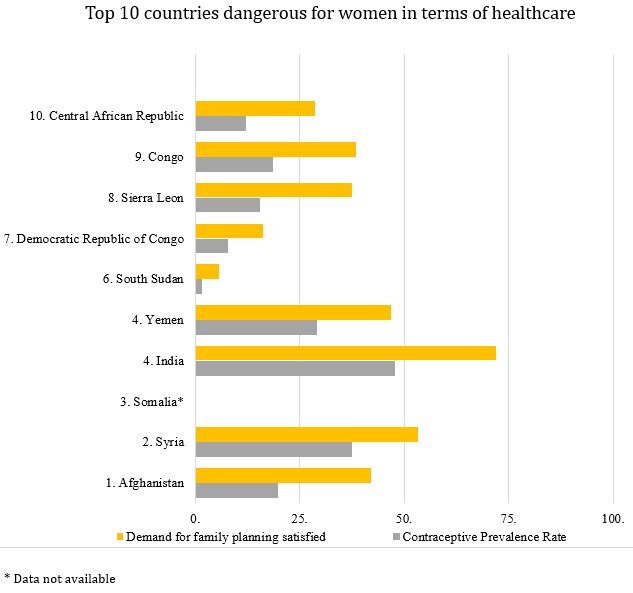 Don’t these charts raise questions about the expertise or knowledge of the respondents? Before we jump to any conclusions, let’s look at some of the other criteria as well.
Don’t these charts raise questions about the expertise or knowledge of the respondents? Before we jump to any conclusions, let’s look at some of the other criteria as well.
TRF’s second question related to discrimination, which included “job discrimination; an inability to make a livelihood; discriminatory land, property or inheritance rights; a lack of access to education; and a lack of access to nutrition”. While TRF gives no indication of which of these wide variables India did so badly on so as to reach the number 3 position, in her interview with NDTV, TRF’s CEO, Monique Villa, did emphasise that women in India own only 10% of the land. While a broader investigation into the parameters would help, let us take up this point since Villa raises it as a point of concern. In the same interview she also said that women across the world own only 20% of global land holdings. By that description, Indian women hold 50% less land than the global average for women. However, a 2015 UN study of the distribution of agricultural land holders among females across 104 countries shows that Indian women fare almost as well as women in the UK or USA on agricultural land holding. Why does Villa not view the comparable figures of land-holding in these countries as being a matter of concern?
Table 1.1 Distribution of agricultural holders (females)
| Countries | Percentage of Women | Year |
| Saudi Arabia | 0.8% | 1999 |
| Bangladesh | 4.6% | 2008 |
| Iran | 5.9% | 2002 |
| Germany | 8.4% | 2010 |
| India | 12.8% | 2010-11 |
| The United Kingdom | 13.1% | 2010 |
| USA | 13.7% | 2012 |
The question on cultural, tribal and religious traditions included sub-categories like acid attacks, female genital mutilation, child marriage, female infanticide etc. In her own article commenting on the TRF study, Villa says that “the basic right to life for girls in India is denied even before they are born” and “abortions of girls still happen by millions, even though ultrasounds have been forbidden by law to try to stop this practice”. Thus, Villa’s main claim is that the skewed sex ratio in India is primarily the result of female infanticide and foeticide.
According to NCRB data, there were a total of 93 recorded infanticides in 2016, which is less than one case per million people, and this number also includes male and female infants. Villa herself states that ultrasounds are forbidden by law, so it is not clear how millions of selective abortions are made possible. Moreover, sex ratio has been found to depend on multiple factors like race, age and nutrition level of parents, the order of birth, time of conception, hormonal influences etc. Thus, it is far from being scientifically established that the sex-ratio skew in India is generated by female foeticide and infanticide.
Let’s look at the area that seems to have sealed India’s fate – sexual violence. It seems as if everybody knows that India has the largest problem of rape in the world. Yet, even a cursory investigation of available statistics reveals a startlingly different picture. According to the latest data available, India has a rape rate of 6.64 whereas countries in the west like England & Wales, USA, Sweden and Belgium have much higher rape rates. (The graph below draws upon statistics from NCRB India, Eurostat, FBI, and South African Police report).
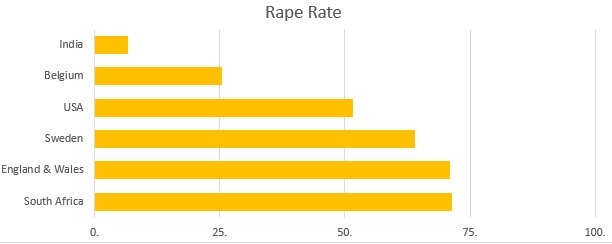 The data provided above are often dismissed by saying that rape is highly underreported. Under-reportage is not a problem persistent only in India. Crime, especially rape, is underreported everywhere in the world and such under-reportage is already well-documented in the USA and UK. In order to take the rape rate somewhere close to that of UK and USA, one has to assume that only about one in 10 rapes are reported in India. But, the claim is that India is much worse. In addition, TRF reporters, including Villa, expressed with a tone of achievement that the only western nation in the list is the USA. This too was explained away by the possible influence the #metoo campaign could have had on the perception of the experts.
The data provided above are often dismissed by saying that rape is highly underreported. Under-reportage is not a problem persistent only in India. Crime, especially rape, is underreported everywhere in the world and such under-reportage is already well-documented in the USA and UK. In order to take the rape rate somewhere close to that of UK and USA, one has to assume that only about one in 10 rapes are reported in India. But, the claim is that India is much worse. In addition, TRF reporters, including Villa, expressed with a tone of achievement that the only western nation in the list is the USA. This too was explained away by the possible influence the #metoo campaign could have had on the perception of the experts.
The last parameter for which India tops the list is human trafficking. A special report published by European Court of Auditors, ‘EU support to fight human trafficking in South/South East Asia’ shows that there is a major flow of people (especially women) from Asia to Europe, North America and the Middle East. According to TRF’s Kieran Guilbert, campaigners against human trafficking say, “Women and girls in India face the biggest threat from traffickers because they are still widely considered to be sexual objects and second-class citizens”. TRF consistently connects crime against women to cultural perceptions. What is not clear, especially in the case of human trafficking, is the following: if the cultural perception of women as “sexual objects” or “second-class citizens” or any number of such perceptions is responsible for their sale, what de-links the buying of women from cultural perceptions? Or, what allows TRF to imply that women are culturally better off in the countries where women are bought than the ones from where they are sold?
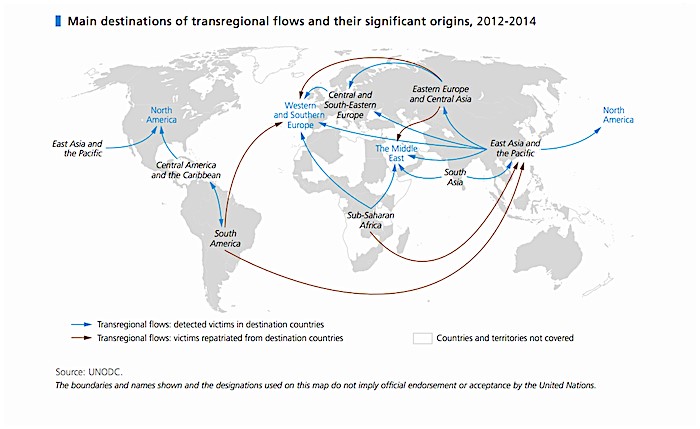 The table below is taken from the statistics presented by the International Labour Organisation (ILO) on forced labour, modern slavery and human trafficking. Why, if the data indicates so, does Europe not feature in answer to this question in the perception poll?
The table below is taken from the statistics presented by the International Labour Organisation (ILO) on forced labour, modern slavery and human trafficking. Why, if the data indicates so, does Europe not feature in answer to this question in the perception poll?
Table 1.2 Forced Labour rate in different regions across the world.
| Regions | Forced Labour per thousand |
| Americas | 1.3 |
| The Arab States | 2.2 |
| Africa | 2.8 |
| Europe and Central Asia | 3.6 |
| Asia and the Pacific | 4.0 |
Any number of contestations that may be entered into on the basis of alternative data available on any of the parameters (or specific variables within the parameters) that TRF asked experts to rate. But, the point of the contestations is not to prove the poll is faulty. The poll is faulty for the reasons already laid out in the previous section. What we should be able to see through this limited examination of counter-data is: (i) As per reliable available data, countries of Europe or the USA would be as likely to appear in the polls with respect to certain of the questions, but they simply did not. (ii) When “expert” responses did seem more in line with available data, as in the case of the USA’s inclusion on sexual violence, TRF either expressed surprise or dismissed this expert evaluation. (iii) The claims about violence against women were tied to implicit claims about culture and not to the data. Thus, one can only understand the poll as a set of predictions, not measurements, on the given parameters. These predictions follow from implicit assumptions about the connection between violence and certain cultures. In other words, since there is no scientifically accepted link between culture and violence, what TRF’s poll documents is the prejudice of “experts”.
Featured Image: Twitter
Disclaimer: The opinions expressed within this article are the personal opinions of the author. IndiaFacts does not assume any responsibility or liability for the accuracy, completeness, suitability, or validity of any information in this article.
Gayathri Devi Sajeev is a PhD candidate at Ghent University, Belgium and a Research Assistant at the SDM Centre for Inter-disciplinary Research in the Humanities and Social Sciences (CIRHS), Ujire, Karnataka.

